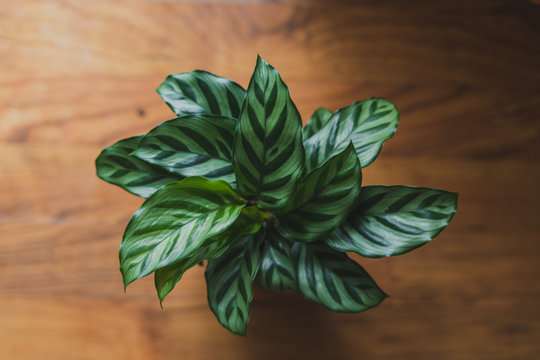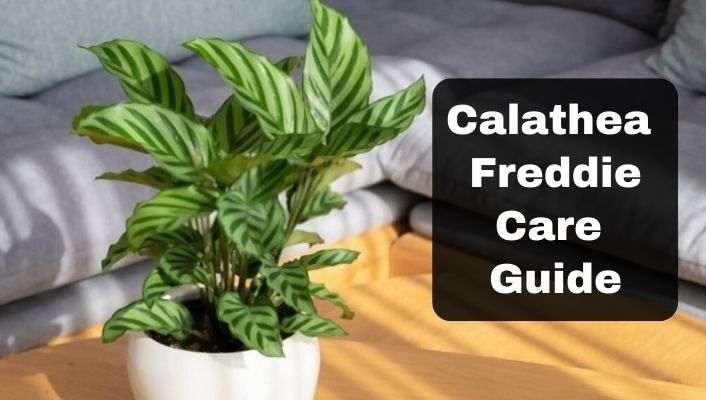Calathea Freddie is a great choice for indoor collection and indoor decoration. It is a beautiful tropical plant and what’s amazing is the unique appearance that differentiates it from other varieties.
Talking about leaves, they are shiny, long and gray-green. Moreover, it has zebra stripes and borders that are the same color but in a darker shade.
This plant is known as Calathea Concinna, Concinna Freddie Prayer Plant, and Freddie Plant. Calathea Freddie is also referred to as a prayer plant. Because it has a habit of folding up at night, the folding is not prominent, but you’ll notice slight leaf changes in it.
It has a great feature of flowers too, during summers you might be able to see tiny delicate white blossoms.
Post Contents
- Calathea Freddie Essential Details:
- Calathea Freddie Plant Size:
- Calathea Freddie Care Needs:
- Potting the Calathea Freddie:
- Repotting Requirements:
- Soil Requirements:
- Correct pH:
- Water Requirements:
- Lighting Requirements:
- Fertilizer Type and Routine:
- Propagating Calathea Freddie:
- Humidity and Aeration:
- Temperature Requirements:
- Pruning:
- Toxicity Information:
- Frequently Asked Questions (FAQs):
- Conclusion:
- Author
Calathea Freddie Essential Details:
Explore essential details about Calathea Freddie, including its name, family, native region, and care essentials.
| Information | Description |
|---|---|
| Common Name | Calathea Freddie |
| Scientific Name | Calathea freddie |
| Family | Marantaceae |
| Native to | Brazil |
| Growth Habit | Herbaceous perennial |
| Leaf Pattern | Oval-shaped with green stripes |
| Leaf Color | Dark green with lighter stripes |
| Light | Medium to bright indirect light |
| Watering | Keep soil consistently moist |
| Humidity | Requires high humidity levels |
| Temperature | Prefers warm temperatures (18-26°C) |
Calathea Freddie Plant Size:
The Calathea Freddie reaches 2-3 feet tall and 4-7 inches wide when mature as a houseplant.
Calathea Freddie Care Needs:
Calathea Freddie needs a lot of proper care, and you’ll have to follow the right instructions for care and maintenance. Freddie Plant loves humidity, and you will have to keep it moist.
Check the detailed guide on Calathea Freddie’s care and maintenance below. Let’s dive into it:
Potting the Calathea Freddie:
Always choose a medium-sized terracotta or clay pot for efficient potting of the Calathea Freddie. The pot should have good drainage holes for the excess water in the soil.

This is because the Freddie plant will never like to stay in soggy soil, and a terracotta pot with drainage holes is best for this purpose. Terracotta pots never retain a lot of water.
Related: Calathea Crocata Care & Growing (Eternal Flame Plant)
Repotting Requirements:
If you want to see a healthy growing Calathea Freddie, and you want its size to get increased. So for this purpose, you should move your plant to a larger pot after it reaches a particular size. We recommend repotting the plant when the roots get bound to the pot and pop out of the drainage hole.
Remember to take special care while repotting. Never disturb or touch the roots of the plant. Always keep in mind that this plant is really sensitive.
For normal knowledge, you can repot the Calathea Freddie every two years. If it doesn’t seem to be repotted, you still should do it because soil loses all the natural and important nutrients as time passes.
Soil Requirements:
You can always use standard commercial potting soil for this particular plant. For this purpose, you can mix it on your own, and we recommend adding components such as peat moss and perlite to make a convenient soil mix.
Always mix up soil that drains well and retains a lot of moisture. Along with this, the soil should be airy enough, so the roots get a good amount of oxygen and breathe better.
Correct pH:
The Freddie Plant likes acidic soil. This means that pH should always remain between 6.0-6.5. If it’s difficult to understand the pH level, we recommend investing in an inexpensive pH testing tool to examine your soil.

If they are low, you can improve the pH levels by using baking soda, calcitic or dolomitic lime, or wood ash in the soil.
Water Requirements:
Calathea Concinna requires a routine of regular watering. Never overwater this plant because it will lead to a huge decline in the health of your plant. Moreover, if the watering routine is rare, it is equally bad as the plant is of tropical origin and needs to stay evenly moist and wet.
We recommend watering your plant using distilled water, filtered water or rainwater because Calathea Freddie doesn’t like the impurities found in tap water, such as fluoride and calcium.
Here’s a quick way to know if your Freddie plant needs water, use your finger and press it on the soil about an inch deep. If you see that it’s moist and wet, it’s fine, and if you feel dry, it needs to be watered.
Lighting Requirements:
The Calathea Freddie requires light for approximately 6-8 hours daily. Place it near a window that receives bright light, but ensure it doesn’t fall directly on the plant. You can use light silk curtains to make a shade for the plant.
Remember, if the light intensity is high and falls directly on the leaves. There is a high chance that the plant leaves will lose their color and get burned. Besides, the leaves can get droopy if the plant receives very little light. If natural light sources are insufficient, you can opt for artificial lights.

Along with all this, your plant can easily grow in medium-light conditions, and you can freely place it in any low-light spot in your home.
Read More: Calathea Flamestar Care Tips (For Perfect Growth)
Fertilizer Type and Routine:
The Concinna Freddie Prayer Plant needs fertilizer in the growing season. The growing season is usually spring and summer. During these seasons, you can fertilize your plant once a month. We recommend going for a balanced fertilizer that is diluted.
As the growth slows down in winter, you don’t need to fertilize it during the winter.
Propagating Calathea Freddie:
You can always propagate your Calathea Freddie if it has grown too tall. You can cut the stem back and save the cuttings for propagation. Various processes, such as division, can do this.
Humidity and Aeration:
Calathea Freddie being a tropical plant, loves high humidity levels. We recommend keeping the air humidity levels around 70% or higher for the best results.
Your lovely Freddie plant will need nourishment from moisture other than the which it receives from the soil. We recommend misting it slightly and keeping bowls of water near the plant. The water will evaporate and make a moist environment.
Last but not the least, you can always invest in an inexpensive humidifier that will provide more regular humidity for your plant. Moreover, you can increase the humidity using the pebble tray method.
Temperature Requirements:
The Calathea Freddie will thrive in a warm environment, so try to maintain temperatures between 65-75 degrees Fahrenheit. As the tropical regions are warm throughout the year, try to keep a constant temperature in your home.
Besides all this, a pro tip is never to use too hot or too cold water for watering purposes. Plus, keep the plant away from heaters and vents. Take extra care during winter and keep it away from open windows.
Pruning:
You can prune the plant using clean and sterilized tools such as a knife or cutting blade. Cut off dead parts, such as leaves. Or you may control the height of this plant by trimming it properly during the growing season in the spring and summer.
Toxicity Information:
This plant is not toxic to humans and animals. If your pet dog or cat ingests it by mistake, it won’t get harmed. The Calathea Freddie doesn’t have any harmful components. But still, we would recommend keeping it out of reach of children and pets.
Frequently Asked Questions (FAQs):
Why does my Calathea Freddie have Brown Leaf Tips?
This can be because of over-fertilization, tap water or lack of moisture. Look for the right reason, and then treat your plant accordingly.
Why are the Leaves of my Calathea Freddie getting Droopy?
If you notice drooping leaves on your plant, it must need water or a humid environment. Moreover, droopy leaves can indicate a start of pest infection.
Why does my Freddie Plant have Yellow Leaves?
It can be caused due to a lot of reasons: less watering, less lightning, energy wastage etc. Look for the right reason before treatment.
Is Calathea Freddie Hard to Care For?
When asked if it’s hard to care for, it is moderate to difficult. The most difficult parts of care are light and soil. Focus on them minutely.
What is the Average Growth Rate of Calathea Freddie?
The plant grows at a moderate rate and gains a height of 2-3 feet when mature.
Conclusion:
Keeping because of this hard routine of care this plant needs. But we guarantee you that this prayer plant will steal the hearts of your visitors because of its stunning striped foliage and beautifully striped leaves.
Calathea Freddie is a great and beautiful houseplant that looks stunning indoors. You will only be at ease when growing this plant if you follow our care recommendations!
We surely recommend having this in your collection. If it needs much care, follow the guide we provided above, and you’ll be good to go. Good Luck on your road to making your fellow plant collectors envious.
Read More About Calathea Plants:

